|
By Jennifer Roesch, History Program Assistant, with the assistance of Malcolm F. Purinton, PhD and History Program Director Faye Charpentier 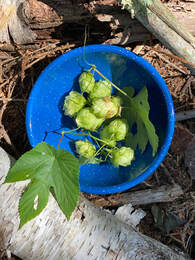 Colonial-era hops found in mid-coast Maine Colonial-era hops found in mid-coast Maine For many of us, the holiday season is a time of celebration, family, and feasting, even while we are in the midst of the global pandemic. While my fiancé and I weren’t able to celebrate Christmas with our families this year, we still curated a Christmas menu, sharing the moments of cooking and consuming with our friends on social media and family over FaceTime. During this time of COVID, we have been living on an island in Maine, working remotely and living an otherwise rather rustic life, where crafting new meals and cocktails have become a sort of new hobby and escape for both of us. While roaming through the woods of the island, we've discovered traces of early English colonists living here during the early 18th century, including wild hops that a settler would've grown to make beer at home. This not only excited me as a public historian, but also my fiancé who is a history professor and whose specialty happens to be the British Empire, specifically the history of beer. In colonial New England, women would often grow imported hops at home to brew beer for their families - a liquid much safer to consume than water at the time. Cider, and hard cider, was also widely consumed from local apples as well as spirits including rum that would have been distilled from the molasses that was imported as part of the Atlantic slave trade. Living with a historian who specializes in food and alcohol history, there are many stories I've heard over the years about how much alcohol was consumed in places like colonial Boston. Even the Puritans consumed alcohol, requiring new towns in Massachusetts to build taverns; Concord, for example, was threatened with a fine for not having one. This surprised me since the Puritans are often associated with abstinence. However, what the Puritans objected was the overconsumption of alcohol, not the consumption of alcohol itself. This played a large role in why Christmas was outlawed in Massachusetts prior to King's Chapel's establishment in 1686. From 1659 until 1681, there was a law that decreed: whoever shall be found observing such days as christmas or the like, either by forbearing labour, feasting, or any other way upon any such account as aforesaid, every such person so offending shall pay for every such offence five shillings as a fine to the country. The Puritans objected to the celebration of Christmas, not just because it was considered a pagan holiday since it is not mentioned in the Bible, but also because of the ways in which the English and other Europeans celebrated Christmas. You can watch the recording of our history program that focuses on this here. In England, as well as in colonial America, the onset of winter was a time when beer, wine, cider, etc. were done fermenting after the earlier Autumn harvest and ready to be consumed - right during the time of Christmas. These libations then played a large role in why there was an overconsumption of food and alcohol during the holiday season. Even the Anglican Book of Common Prayer, used by the 18th century King's Chapel congregation, warned of overconsumption in the Collect of the First Sunday of Advent - when the celebrations typically began near the beginning of December - saying, “Let us walk honestly, as in the day; not in rioting and drunkenefs, not in chambering and wantonnefs…” 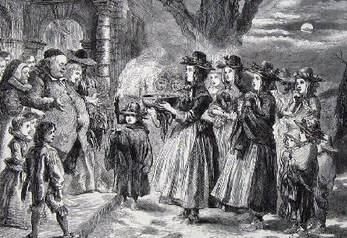 Wassailers in England from historic-uk.com Wassailers in England from historic-uk.com Yet, we still have plenty of records that show the extent of rioting and drunkenness during the season of Christmas in England as well in as places like colonial Boston. English Christmas-time traditions incorporated rowdiness and debauchery, which Puritans found offensive to correlate with a holiday intended to celebrate Jesus’s birth. One tradition was "wassailing" where groups of people - mostly young men - would drink and go rowdily around town, pre-dating the concept of Christmas caroling. Often times, these wassailers would dress in costumes, ranging from animal costumes to crossdressing, and rove around to homes of the wealthy, including employers and landlords, sing bawdy songs or perform skits, and demand food, drink, and money. In New England, this practice was especially common among fishermen and mariners in working-class port cities, including Boston. Records show that wassailing took place regularly in Boston in the 1760s and in the following decades, though the practice likely was occurring much earlier. With this in mind, it is not surprising that the Puritan preacher Cotton Mather published an anti-Christmas sermon in 1712: “Tis an Evident Affront unto the Grace of God, for Men to make the Birth of Our Holy Saviour an Encouragement and an Occasion for very Unholy Enormities...Can you in your Conscience think that our Holy Saviour is honoured by Mad Mirth, by long Eating, by hard Drinking, by lewd Gaming, by rude Revelling, by a Mass fit for none but a Saturn or a Bacchus, or the Night of a Mahometan Ramadam?....Shall it be said That at the Birth of our Saviour, for which we owe as High Praises to God as [the Heavenly host can do], We take the Time to please the Hellish Legions, and to do Actions that have much more Hell than of Heaven in them?” The King's Chapel Annals mention that the church published a counter-sermon in response to Mather's anti-Christmas one. What is even more fascinating that the Annals also mentions that in 1714 there were complaints that because Christmas fell on a Saturday, King's Chapel did not observe the regular Sunday sabbath, disrupting Puritan services with loud work noises. So what did these rowdy wassailers drink?! That especially peaked the interest of me and my fiancé. Depictions of wassailing, like the one below, almost always centers around a large cup or bowl, called a "wassail bowl," containing the alcoholic punch, simply called "wassail." 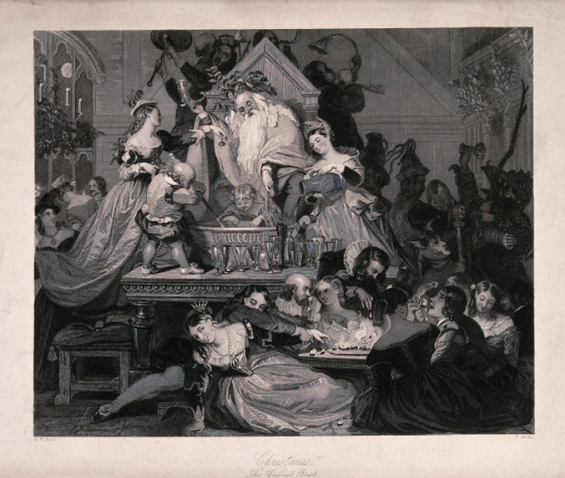 Buss, Robert William, Hollis, T.. Christmas celebrated by people playing instruments, eating and drinking: a man with white hair and a long white beard sitting watching a small man stirring punch in a bowl. Engraving by T. Hollis after R.W. Buss.. Engravings.. Place: Wellcome Collection. https://library-artstor-org.ezproxy.neu.edu/asset/24885598. 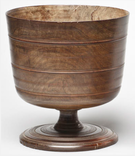 18th century English wassail bowl from the UK National Trust Collection. 18th century English wassail bowl from the UK National Trust Collection. A quick Google search of "wassail bowl" resulted in endless examples of their current locations in English historical societies, antique shops, etc. These bowls were often carved from wood, but other variations such as pewter and silver were also common. What connected these different types of wassail bowls was the size - they were large enough punch to share and drink with others. We took some time to find a more authentic recipe of the punch that would have crossed the Atlantic to colonial Boston and landed on a recipe from Punch. 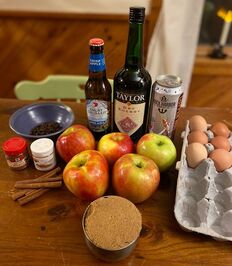 Ingredients for wassail punch. Ingredients for wassail punch. What made this recipe stand out is that the ingredients would have been accessible to many people in 18th century Boston. The eggs and apples would be easy to find and the ale and cider could have been brewed at home, while the sherry wine and spices would have been available at a shop with imported goods. Additionally, this just seemed like a fun and unique recipe for us to try in our own cabin kitchen. Many cocktail recipes of this age included the mixing of several kinds of alcohol, though not in the same way as cocktails today consist of mixing spirits. Other drinks mixed ale and cider together, while "Flips" would have also included eggs in most recipes. 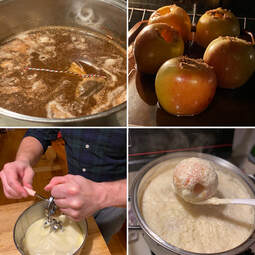 Making the wassail Making the wassail This wassail recipe essentially had four phases, including baking sugared apples, heating a mixture of ale, cider, and sherry with spices (mulling), separating and beating egg whites and yokes, and then adding the apples and eggs to the large pot. To be completely honest, neither of us were optimistic that we would actually like the end result since historically accurate drinks are usually not very good to a modern palate. Beer and cider, for example, were not typically as carbonated with forced carbonation until around the early 20th century. Therefore, an actual wassail punch would have been less bubbly than what we made with the ale and cider we found at the local island markets. But much to our surprise, we actually enjoyed the wassail! 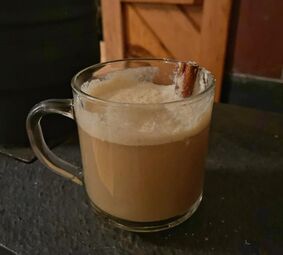 Wassail punch, garnished with a cinnamon stick Wassail punch, garnished with a cinnamon stick The spices and sweetness of the apples, mixed with the warm mixture of sherry, ale, and cider was reminiscent of the mulled wine we usually enjoy over the holidays. Though after a second helping, the thrill of the punch wore off and left us mystified of a time when colonists would walk around town all night drinking large quantities of a variation of this wassail. Perhaps in a post-COVID world, we will bring a large bowl of wassail to a holiday party and share the story of living through a pandemic, making wassail for the first time. But for now, we will continue to explore an enjoy creating new and historic recipes.
0 Comments
Sugar and Spice and Everything Nice: a vegan public historian whips up a Figgy Pudding for today.12/26/2020 By Faye Charpentier, History Program Director 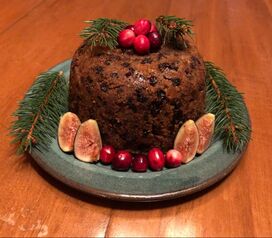 Food has been a method of connecting people and sharing culture across time and place. And related to that role food plays, taste and smell are some of the most powerful triggers of memory. It’s no wonder, then, that food plays an important role in the holiday traditions of so many people. This year, I tried making a traditional Christmas dessert that is new to me, but likely seen on the Christmas tables of King’s Chapel members in the 1700s: a Christmas pudding. As a homebaker and diehard fan of The Great British Baking Show, I have seen variations of these puddings, but had never seen one in real life. “Pudding” as I grew up with, is very different from the “puddings,” or “puds,” bakers are asked to make on the show. That said, special desserts of this variety likely would have been familiar to the colonial Anglicans who worshipped at King’s Chapel. Christmas Services and Songs at King's Chapel: English Traditions to Today's Celebrations12/17/2020 By Faye Charpentier, History Program Director Earlier this month, our “holiday history” focused on some of the cultural and secular aspects of Christmas traditions at churches like King’s Chapel. But Christmas, of course, is a religious holiday at its core. This week, as Christians around the world prepare to celebrate Christ’s birth, our history content focuses on what Christmas services looked like in King’s Chapel’s history as well as what music was incorporated into it. From its founding in 1686 through the American Revolution in the 1770s and 1780s, King’s Chapel was home to an Anglican congregation and followed a specific liturgy, held in common by all Churches of England in Britain and her colonies. By the time King’s Chapel was founded, the church’s liturgy was historic in its own right.
By Faye Charpentier, History Program Director
By Faye Charpentier, History Program Director
Over the course of several hours and with the help of many hands from these dedicated volunteers, Christmastime has arrived at King’s Chapel. While “greening” for the holidays is now a fairly commonplace tradition throughout the United States not just at churches but at office buildings, banks, coffee shops and restaurants, and homes, this was not always the case. Shortly after King’s Chapel was founded in Boston in 1686, it was the first, and likely one of the only, buildings in New England, let alone Boston, to be decked out in greenery each December. As explored in further detail in a virtual program presented this year, Christmas was not widely celebrated in colonial New England, primarily due to religious and cultural differences between the several sects of Christian colonists. This is not to say that New Englanders had not previously celebrated Christmas until 1686, but rather that the establishment of King’s Chapel as the state-sponsored English church brought the first large scale and organized Christmas observances to the region. By the 1690s, King’s Chapel and its members were partaking in one of the oldest known traditions associated with the holiday: greening.
|
King's Chapel History ProgramDive deeper into King's Chapel's 337 year history on the History Program blog. Archives
July 2023
Categories
All
|

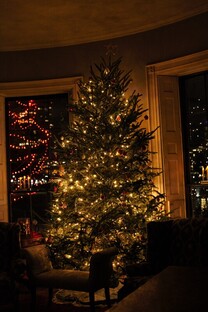
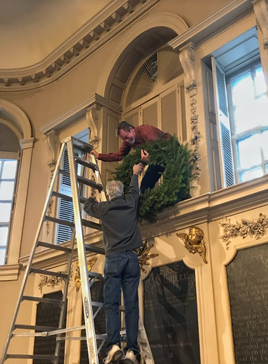
 RSS Feed
RSS Feed